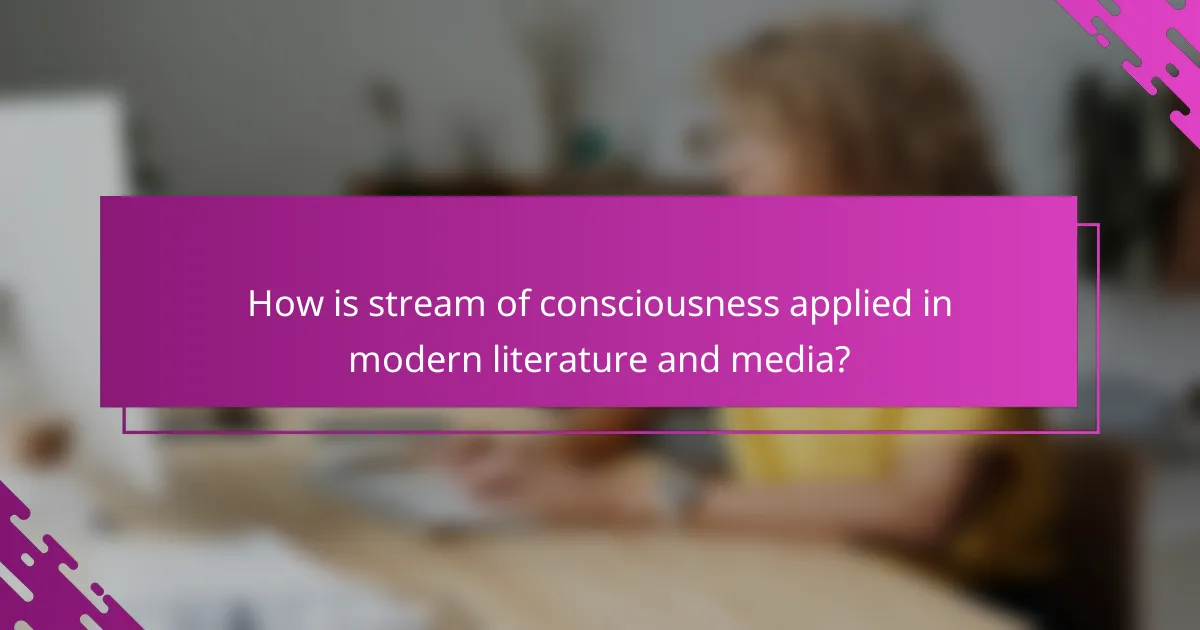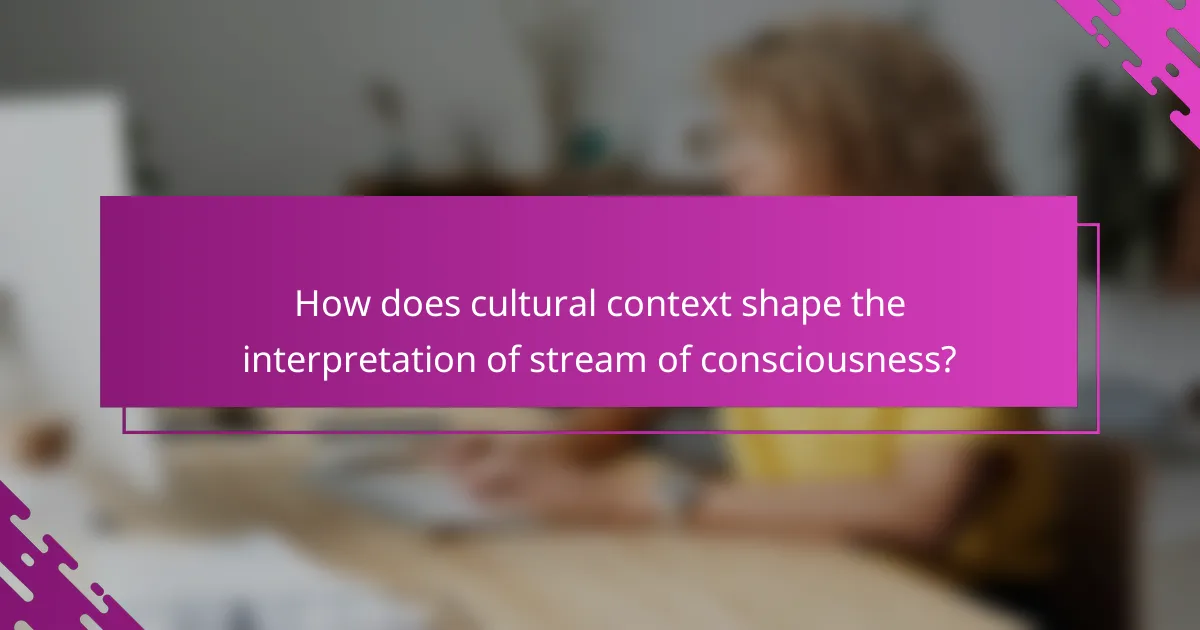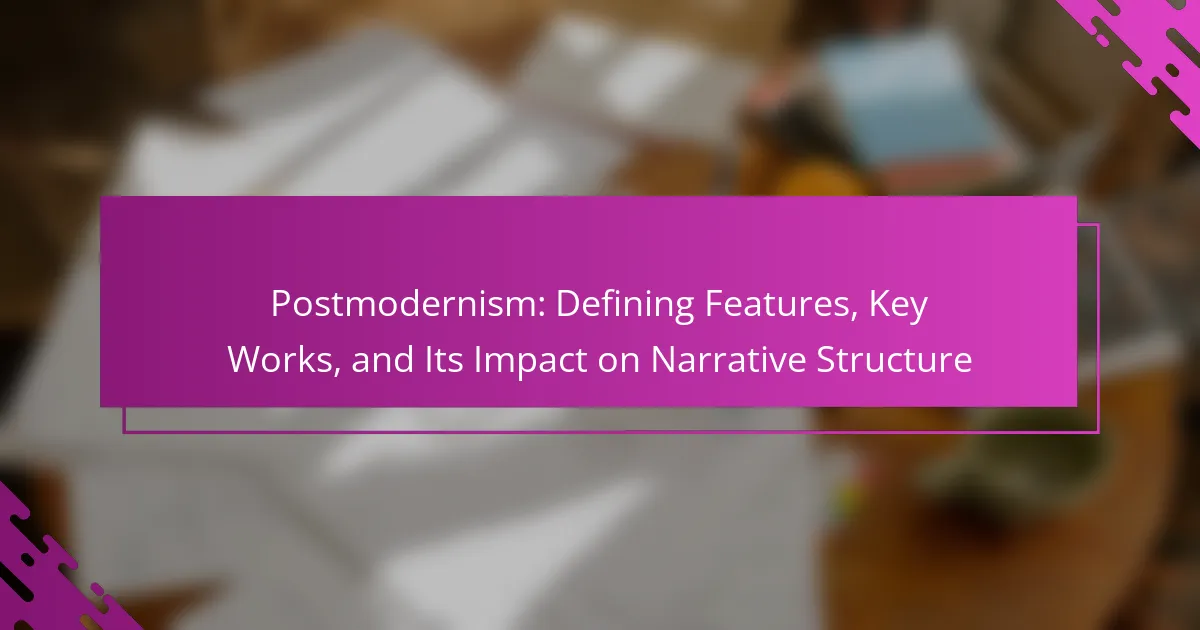Stream of consciousness writing enhances creativity and character insights while presenting challenges in coherence and reader engagement. This article explores techniques like free association and interior monologue, discusses the benefits of this narrative style, examines its modern applications in literature and media, and considers cultural influences on interpretation. By understanding these aspects, writers can effectively navigate the complexities of capturing human consciousness.

What are the key techniques used in stream of consciousness writing?
Stream of consciousness writing employs techniques such as free association, interior monologue, and fragmented narrative. These methods allow writers to capture the flow of thoughts and emotions in a natural, unstructured manner. Free association encourages spontaneous connections between ideas, while interior monologue presents a character’s thoughts directly. Fragmented narrative disrupts traditional storytelling, reflecting the complexity of human consciousness. Together, these techniques enhance the depth and authenticity of literary works.
How do free association and unfiltered thought contribute to the technique?
Free association and unfiltered thought are essential in stream of consciousness techniques as they allow unrestricted expression of ideas and emotions. This spontaneity fosters creativity and depth in writing. By prioritizing instinctive thoughts, writers can uncover unique insights and rare perspectives that structured approaches might overlook. This technique enhances the authenticity of the narrative, making it resonate more with readers.
Which literary devices enhance stream of consciousness narratives?
Literary devices that enhance stream of consciousness narratives include interior monologue, free association, and fragmented syntax. These techniques create a deeper connection to characters’ thoughts and emotions, allowing readers to experience their mental processes directly. Interior monologue captures characters’ inner dialogues, while free association reflects the natural flow of thoughts. Fragmented syntax can convey disjointed thinking, emphasizing the chaotic nature of consciousness. Each device contributes to the immersive experience of this narrative style.
How can punctuation and formatting affect the flow of thoughts?
Punctuation and formatting significantly influence the flow of thoughts in stream of consciousness writing. Proper use of punctuation helps convey the rhythm and pacing of thoughts, while formatting can enhance clarity and emotional impact. For instance, varied sentence lengths can create tension or relaxation, guiding the reader through the writer’s mind. Additionally, strategic breaks, such as paragraphing or line breaks, can emphasize shifts in thought or mood, making the narrative more engaging. Overall, these elements work together to reflect the complexity of human thought processes.
What role does character perspective play in shaping the narrative?
Character perspective significantly shapes the narrative by influencing how events are perceived and interpreted. It determines the emotional depth and connection readers feel with characters. Diverse perspectives can reveal different truths, enriching the story’s complexity. For instance, a first-person perspective offers intimate insights, while a third-person perspective provides broader context. This technique enhances reader engagement and can drive thematic exploration. Ultimately, character perspective is vital in creating a compelling and multifaceted narrative experience.

What benefits does stream of consciousness writing offer to authors?
Stream of consciousness writing offers authors enhanced creativity, deeper character insights, and improved narrative flow. This technique allows writers to express thoughts and emotions in a fluid manner, fostering authenticity. As a result, it can lead to more engaging and relatable storytelling. Additionally, it encourages experimentation with language and structure, pushing the boundaries of traditional writing forms.
How does it deepen character development and emotional connection?
Stream of consciousness deepens character development and emotional connection by providing intimate access to a character’s thoughts and feelings. This technique allows readers to experience a character’s internal struggles and motivations in real time, fostering empathy. As a result, characters become more relatable and complex, enhancing the overall narrative. The unique attribute of this method is its ability to blur the line between narration and a character’s psyche, creating a profound bond between the reader and the character.
In what ways does it enhance thematic exploration and complexity?
Stream of consciousness enhances thematic exploration and complexity by allowing deep psychological insights and fluid narrative structures. This technique captures characters’ thoughts and emotions in real-time, creating a rich tapestry of subjective experiences. By blurring the lines between reality and perception, it invites readers to engage with themes of identity, time, and consciousness. The resulting complexity fosters a more immersive reading experience, encouraging personal interpretation and reflection.
How can it improve writing fluidity and creativity?
Stream of consciousness techniques enhance writing fluidity and creativity by encouraging free expression of thoughts. This method allows writers to explore ideas without rigid structure, fostering spontaneity. As a result, it can lead to unexpected insights and deeper emotional connections in writing. Techniques such as freewriting and associative thinking stimulate creativity by breaking conventional boundaries, allowing for richer narrative development.

How is stream of consciousness applied in modern literature and media?
Stream of consciousness is widely used in modern literature and media to convey characters’ thoughts and emotions. This technique allows for a more immersive experience, reflecting the complexities of human consciousness.
Authors like Virginia Woolf and James Joyce pioneered this style, influencing contemporary writers. In film and television, directors utilize similar techniques through voiceovers and nonlinear narratives, enhancing emotional depth.
The technique’s benefits include fostering a deeper connection with characters and presenting a more authentic portrayal of mental processes. As a result, stream of consciousness remains a vital tool for exploring the human experience in various creative forms.
Which contemporary authors are known for their use of this technique?
Contemporary authors known for their use of stream of consciousness include Virginia Woolf, James Joyce, and William Faulkner. These writers effectively capture characters’ inner thoughts and emotions, creating immersive narratives. Their works showcase the technique’s unique ability to explore complex psychological states, enhancing reader engagement.
How has stream of consciousness influenced film and visual storytelling?
Stream of consciousness has profoundly influenced film and visual storytelling by enhancing character depth and narrative complexity. This technique allows filmmakers to depict the inner thoughts and emotions of characters, creating a more immersive experience.
Techniques such as non-linear narratives and fragmented editing mirror the flow of thoughts, allowing viewers to engage with characters on a psychological level. For example, films like “Eternal Sunshine of the Spotless Mind” utilize this approach to explore memory and emotion, reflecting the chaotic nature of human consciousness.
The benefits of this influence include increased emotional resonance and a deeper understanding of character motivations. By prioritizing subjective experience, filmmakers can evoke empathy and connection, enriching the audience’s engagement.
Modern applications of stream of consciousness can be seen in various genres, from drama to experimental films. This technique continues to evolve, adapting to new storytelling mediums, such as virtual reality, where immersive experiences can replicate the fluidity of thought in real-time.
What are the applications in digital media and interactive narratives?
Stream of consciousness techniques are widely used in digital media and interactive narratives to create immersive experiences. These techniques allow for fluid character thoughts and emotions, enhancing storytelling. They engage audiences through non-linear narratives, fostering deeper connections with characters. Modern applications include video games, interactive films, and virtual reality experiences, where players navigate complex emotional landscapes. This approach enriches user engagement, making narratives more relatable and impactful.

What challenges do writers face when employing stream of consciousness?
Writers face several challenges when employing stream of consciousness techniques. These challenges include maintaining coherence, managing character development, and ensuring reader engagement. The non-linear narrative can confuse readers, making it difficult for them to follow the plot. Additionally, balancing the internal thoughts with external actions often leads to over-exposition, diluting the impact of the narrative. Writers must navigate these complexities to effectively convey characters’ inner experiences while keeping the story accessible.
How can maintaining coherence be difficult in this style?
Maintaining coherence in stream of consciousness writing can be challenging due to its inherent nature of fluid thoughts. This style often lacks traditional structure, making it difficult for readers to follow the narrative. The rapid shifts in focus can lead to disjointed ideas that may confuse the audience. Additionally, the absence of clear transitions can disrupt the flow, making it hard to maintain a consistent theme throughout the piece.
What are common pitfalls in reader engagement and comprehension?
Common pitfalls in reader engagement and comprehension include lack of clarity, overwhelming information, and insufficient connection to the reader’s interests. Clarity is essential; complex language can alienate readers. Overloading content with information can lead to confusion, causing readers to disengage. Failing to relate topics to the reader’s experiences diminishes relevance, reducing their motivation to engage. Understanding these pitfalls is crucial for enhancing reader interaction and comprehension.

How does cultural context shape the interpretation of stream of consciousness?
Cultural context significantly influences how stream of consciousness is interpreted. Different cultures shape the way thoughts and emotions are expressed, affecting narrative style and reader engagement.
For instance, Western literature often emphasizes individualism, leading to introspective narratives, while Eastern traditions may focus on collective experiences, resulting in more communal expressions. These cultural frameworks determine the reader’s understanding and emotional resonance with the text.
Moreover, language nuances also play a role. Idiomatic expressions and cultural references embedded in a narrative can alter the perception of a character’s mental state. As a result, readers from different backgrounds may derive distinct meanings from the same stream of consciousness passage.
In summary, cultural context not only shapes narrative techniques but also enhances the richness of interpretation, highlighting the diversity of human experience.
What differences exist in perception across various literary traditions?
Stream of consciousness techniques vary across literary traditions, influencing perception and narrative style. Different cultures emphasize unique aspects, such as emotional depth or temporal fluidity. For instance, modernist writers often prioritize internal monologue, while postmodernists may blend reality with fragmented thoughts. This diversity enriches literature, allowing for varied interpretations and emotional engagement.
How do regional storytelling methods influence the technique?
Regional storytelling methods significantly shape the stream of consciousness technique by reflecting cultural nuances. Different regions employ varied narrative styles, influencing how thoughts and emotions are expressed. For instance, in some cultures, storytelling may prioritize collective experiences, while others emphasize individual perspectives. This diversity enriches the technique, allowing for a broader range of emotional depth and complexity in contemporary literature. Additionally, regional dialects and idioms infuse authenticity into the narrative, enhancing the reader’s connection to the text.

What are some best practices for effectively using stream of consciousness?
To effectively use stream of consciousness, focus on free expression and authenticity. Embrace techniques like unfiltered writing, sensory details, and nonlinear narratives. These practices enhance creativity and allow deeper exploration of thoughts. Modern applications include personal journaling, creative writing, and therapy, promoting self-discovery and emotional release.
How can writers balance clarity with the flow of thoughts?
Writers can balance clarity with the flow of thoughts by using techniques like structured outlines and stream of consciousness. These methods enhance coherence while allowing natural thought progression. Techniques such as free writing encourage fluidity, while revising emphasizes clarity. Writers should also consider their audience to maintain engagement without sacrificing understanding.
What strategies can be used to refine and edit stream of consciousness pieces?
To refine and edit stream of consciousness pieces, focus on clarity and coherence. Start by identifying key themes and restructuring sentences for flow. Eliminate redundant phrases and ensure each thought connects logically. Use punctuation to create pauses, enhancing readability. Lastly, consider the emotional impact of word choice to maintain the intended tone.
What common mistakes should writers avoid in this narrative style?
Writers should avoid common mistakes like excessive inner monologue, lack of clarity, and neglecting character development. These pitfalls can lead to confusion and disengagement from readers. Focusing on concise expression and maintaining a coherent narrative flow is essential for effective stream of consciousness writing.



